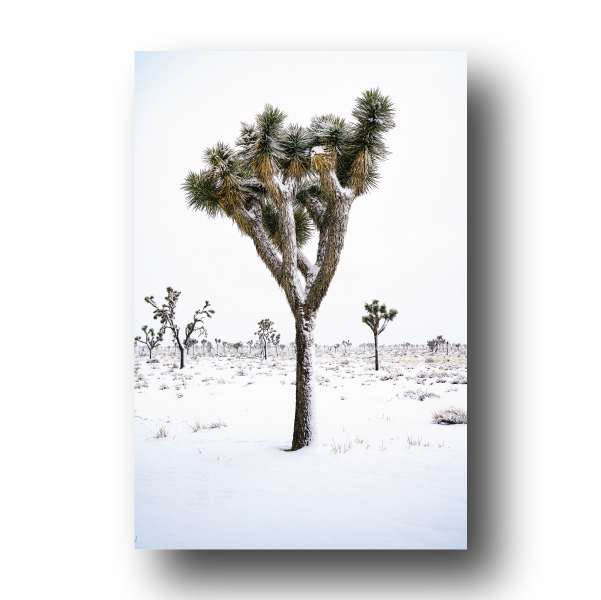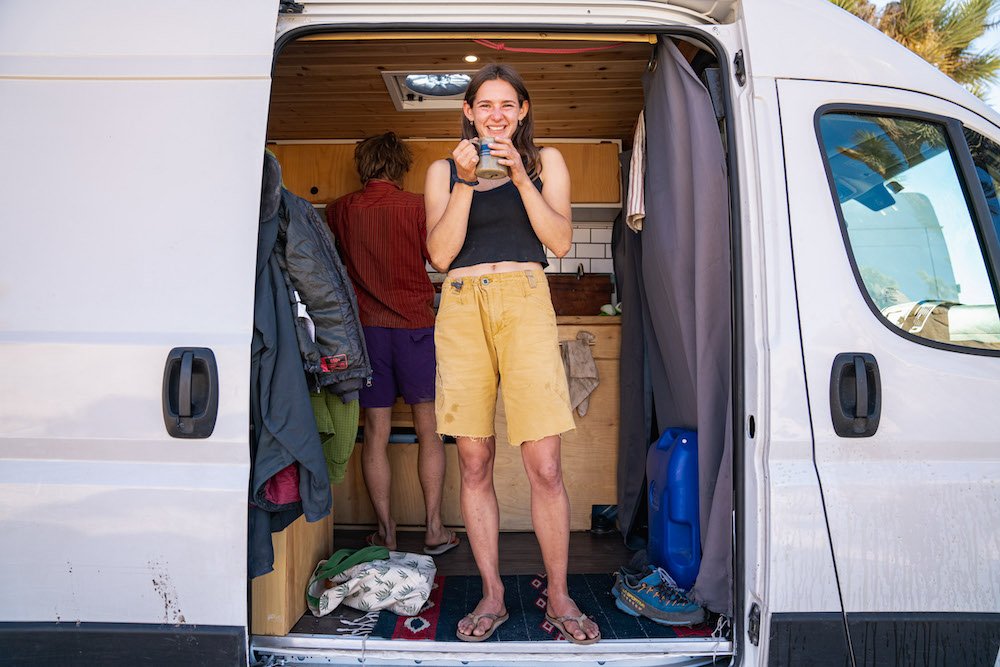Joshua Tree National Park is a climber's paradise, with its iconic rock formations and stunning desert landscapes. But before you embark on your rock climbing adventure, you need to secure the perfect camping spot. Whether you prefer the convenience of campgrounds within the national park or the tranquility of Bureau of Land Management (BLM) land just outside its boundaries, here's what you need to know about finding the ideal base for your Joshua Tree experience.
Finding a secluded BLM spot outside of Joshua Tree NP, CA. Photo by Dalton Johnson
Pros
Stunning Scenery: The unique desert landscapes and iconic Joshua trees provide a picturesque backdrop for your camping experience.
Rock Climbing Opportunities: Joshua Tree is a world-renowned rock climbing destination, offering a wide range of climbing routes for all skill levels.
Stargazing: The park's remote location and low light pollution make it one of the best places for stargazing in the United States.
Hiking Trails: There are numerous hiking trails, from short walks to longer treks, allowing you to explore the desert's beauty on foot.
Bouldering: In addition to traditional rock climbing, the park offers excellent bouldering opportunities, attracting climbers from around the world.
Wildlife Viewing: You can spot desert wildlife such as bighorn sheep, desert tortoises, and various bird species while camping in the area.
Photography: The striking rock formations and desert flora make Joshua Tree a paradise for photographers.
Unique Flora: Experience the otherworldly beauty of the Joshua trees and the park's diverse desert flora.
Peace and Solitude: Camping in the desert provides a sense of tranquility and escape from the hustle and bustle of daily life.
Sunrises and Sunsets: Witness breathtaking sunrises and sunsets that paint the desert with vibrant colors.
Cons
Extreme Temperatures: The desert climate can bring scorching daytime temperatures and chilly nights, requiring appropriate clothing and gear.
Limited Water: Water sources are scarce, and you may need to carry your own water or rely on campground facilities.
Crowded Campgrounds: Campgrounds within the park can fill up quickly, especially during peak seasons, making it challenging to secure a spot.
Campsite Availability: First-come, first-serve campgrounds may require arriving early, which can be inconvenient for travelers with fixed schedules.
Lack of Amenities: Some campgrounds offer minimal amenities, including no showers or limited restroom facilities.
No Hookups: Many campgrounds lack RV hookups, making it less convenient for RV campers.
Limited Cellular Reception: Expect limited or no cell phone signal in some areas of the park, which can impact communication and navigation.
Distance from Services: Joshua Tree is somewhat remote, so access to groceries, gas, and other services may require a drive.
Wildlife Hazards: While wildlife viewing is a pro, it's essential to be aware of potential encounters with rattlesnakes and scorpions in the desert.
Leave No Trace Responsibility: Visitors must adhere to strict Leave No Trace principles to protect the fragile desert ecosystem, which may require extra effort and awareness.
Campgrounds Inside Joshua Tree National Park
Inside Joshua Tree National Park, you'll find a selection of campgrounds that cater to both climbers and nature enthusiasts. However, these campgrounds can fill up quickly during peak climbing seasons, so planning ahead is essential.
Reservations and Availability
Some of the most popular campgrounds within the park include Hidden Valley, Belle, and Ryan. If you have specific dates in mind, it's highly recommended to make reservations well in advance. The demand for these campgrounds is high, and securing a spot can be competitive.
First-Come, First-Serve
While Belle campground does accept reservations, others, like Hidden Valley and Ryan, operate on a first-come, first-serve basis. To increase your chances of snagging a spot during peak times, plan to arrive early in the day. Being an early bird can make all the difference in securing a coveted campsite.
Amenities
Campgrounds within Joshua Tree National Park offer varying amenities. Some provide only basic facilities, while others offer restrooms and water. It's advisable to check the park's website for the most up-to-date information on each campground's amenities, so you can better plan for your stay.
Proximity to Climbing Areas
Consider the location of your chosen campground in relation to the climbing areas you intend to visit. Some campgrounds are conveniently situated near popular climbing spots, minimizing travel time. Carefully selecting a campground that aligns with your climbing objectives can enhance your overall experience.
Camping Outside Joshua Tree National Park on BLM Land
If securing a spot within the national park proves challenging, fear not. There are alternative camping options on BLM land just outside the park boundaries. These sites offer a more rustic camping experience and are often less crowded.
No Reservations Required
Most BLM camping areas operate on a first-come, first-serve basis, eliminating the need for reservations. However, arriving early is still advisable, particularly during peak climbing seasons, to ensure availability.
Self-Reliance
BLM campgrounds typically offer fewer amenities than those inside the park. Be prepared to be more self-reliant by bringing your own water and camping supplies. The trade-off is often a quieter and more immersive experience in the desert landscape.
Leave No Trace
When camping on BLM land, it's essential to adhere to Leave No Trace principles. This means packing out all trash, minimizing your impact on the environment, and showing respect for the land. Maintaining these principles is crucial for preserving the natural beauty of Joshua Tree and ensuring future generations can enjoy it as well.
Campfire Regulations
Before lighting a campfire, check local fire regulations. In the dry desert environment of Joshua Tree, fires may be restricted or prohibited during certain times of the year. Always prioritize safety and the preservation of the ecosystem when considering a campfire.
Inside VS Outside the Park
Inside Joshua Tree National Park:
Camping within the boundaries of Joshua Tree National Park offers a truly immersive experience in the heart of this desert wonderland. Inside the park, you'll find campgrounds like Hidden Valley, Belle, and Ryan, each with its unique charm. The advantage of camping here is the unparalleled proximity to the park's iconic rock formations and hiking trails. If you're a rock climber, waking up within the park means you're just minutes away from world-class climbing routes, making early morning climbs and sunset bouldering sessions a breeze.
However, there are some considerations to keep in mind. Campgrounds inside the park can be in high demand, especially during peak seasons. While some accept reservations, others operate on a first-come, first-serve basis, so arriving early is key. Additionally, amenities can vary from campground to campground, ranging from basic facilities to those with restrooms and water. So, if you value convenience and proximity to the park's attractions, camping inside Joshua Tree National Park might be your preferred choice.
Outside Joshua Tree National Park:
For those seeking a more rustic and secluded camping experience, the Bureau of Land Management (BLM) land just outside Joshua Tree National Park provides an appealing alternative. Camping on BLM land often means fewer crowds and a closer connection to the desert's natural beauty. While amenities may be limited compared to campgrounds inside the park, this self-reliant style of camping allows you to fully immerse yourself in the desert environment.
One significant advantage of camping outside the park is the lack of reservation hassles. Most BLM camping areas operate on a first-come, first-serve basis, eliminating the need for advance planning. However, be prepared to bring your own water and supplies, as BLM campgrounds typically offer fewer amenities. This choice is ideal for those who crave solitude, appreciate the Leave No Trace principles, and are ready to embrace the desert's wild side while enjoying the convenience of being just a short drive away from Joshua Tree's attractions.
Dirtbags enjoying a Hidden Valley campsite in Joshua Tree. Photo by Dalton Johnson
By carefully considering your camping options both inside Joshua Tree National Park and on BLM land outside the park, you can secure a comfortable and convenient base for your rock climbing adventures. Whether you prefer the amenities of a developed campground or the solitude of BLM land, thoughtful planning will help you make the most of your climbing trip to this desert paradise. So, pack your gear, plan your stay, and get ready for an unforgettable climbing experience in Joshua Tree National Park!








